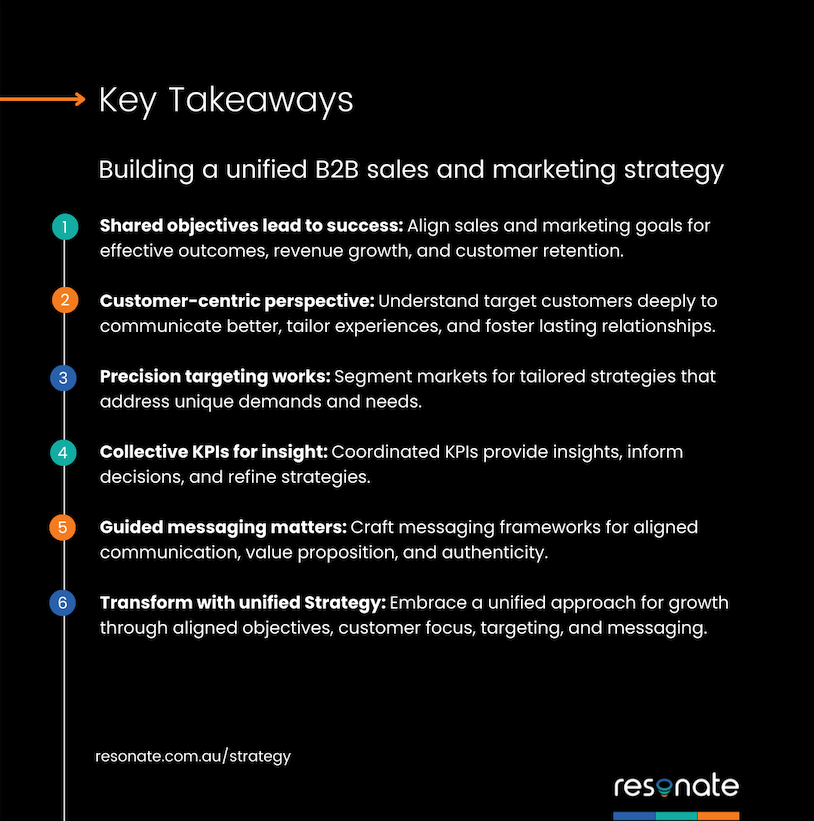In B2B, there has been a historical separation between sales and marketing functions, despite their shared goals, which has often led to incongruences. Sales teams responsible for product promotion have, at times, found themselves disconnected from crucial product strategy discussions, resulting in misalignments between marketing messages and sales pitches.
To achieve optimal outcomes, the alignment of sales and marketing objectives is crucial. Without this harmony, a B2B enterprise risks diminishing its effectiveness in closing deals. In traditional practices, sales and marketing operated as isolated entities within the sales funnel. However, the digital transformation of B2B has rendered this approach inadequate. Today’s customer engagement spans pre- and post-purchase interactions, necessitating a unified B2B sales and marketing strategy that harnesses the strengths of both domains.
This blog aims to guide business leaders seeking to develop a cohesive B2B sales and marketing strategy to drive revenue and cultivate customer satisfaction.

Identify shared objectives
Harmonising your B2B sales and marketing strategy involves identifying shared objectives between the two functions. Your integrated team should possess a clear, mutually agreed-upon understanding of these objectives and anticipated outcomes. These shared goals encompass
elevating company revenue, enhancing customer awareness of products and services, and expanding the customer base while nurturing existing relationships. The fusion of these aspects crystallises the strategy’s purpose. Concurrently determine the resource allocation for your B2B sales and marketing strategy and pinpoint the channels you seek to leverage.
Forge a holistic customer perspective
“Today’s customer engagement spans pre- and post-purchase interactions, necessitating a unified B2B sales and marketing strategy that harnesses the strengths of both domains.”
While many B2B enterprises might compile lists of target companies, going beyond a mere inventory of business names becomes vital. Achieving a holistic customer perspective entails comprehending the core attributes, needs, preferences, behaviours, and motivations that define your target customers.
The benefits stemming from such a comprehensive view are manifold. It fosters seamless communication between sales and marketing teams, empowering informed and collaborative decision-making. This approach also facilitates tailored purchasing journeys aligned with individual customer requirements, inclinations, and behaviours. Closing the loop between sales and marketing facilitates valuable feedback on lead outcomes and refines strategies. Moreover, this encompassing perspective enriches customer lifecycle marketing, nurturing enduring customer relationships. Ultimately, embracing a thorough customer perspective streamlines B2B sales and marketing strategies, optimising time and resources.
Precision targeting through market segmentation
Market segmentation involves dividing your target audience into manageable clusters characterised by shared attributes. To foster a unified B2B sales and marketing strategy, meticulous identification and segmentation of your target market are essential. This process is guided by understanding customer needs and challenges, ensuring a tailored approach.
Such segmentation encompasses a range of parameters, including the company size of your customers, patterns of segment growth, the history of customer interactions, the competitive landscape, and specific product requirements or needs. Each distinct market segment presents unique demands. By delving deeply into your customers’ intricacies, your business gains the ability to address these varying needs, thereby empowering adept strategic fulfilment.
Coordinated tracking of key performance indicators (KPIs)
Measuring performance is essential for every business, and Key Performance Indicators (KPIs) are a reliable means of doing this. Sales and marketing often have separate KPIs, creating a longstanding challenge in their alignment. Combining sales and marketing KPIs unites them under a common goal. You can monitor their joint effectiveness and identify gaps by measuring them with the same metrics.
A robust joint KPI provides insights into the performance of both sales and marketing endeavours. Notable examples encompass evaluating the return on marketing investment (ROMI), total sales and revenue, sales originating from new business opportunities, and the conversion rate from Marketing Qualified Leads (MQL) to Sales Qualified Leads (SQL).
Craft a unified messaging framework
Content marketing has emerged as a potent and widely embraced B2B marketing strategy, skilfully guiding prospective leads through the intricate channels of the sales and marketing funnel. To enhance the efficacy of your B2B sales and marketing strategy, the integration of a well-defined messaging framework is recommended. This framework serves as a guiding compass, directing communication and content development seamlessly across both the sales and marketing domains.
Within your B2B messaging framework, several essential components come into play. Commence with a comprehensive understanding of your target market, delving deeply into their specific pain points. Subsequently, articulate your unique selling proposition with precision, spotlighting how your products or services adeptly address customer challenges. Prioritise the seamless integration of compelling Calls-to-Action (CTAs) that succinctly encapsulate the inherent value of your offerings. Finally, reinforce your company’s industry positioning with credible substantiation, thereby enhancing authenticity and fostering trust.
Conclusion
“Integrating a well-defined messaging framework further empowers businesses to navigate this path confidently, nurturing customer relationships and driving revenue growth.”
In today’s dynamic B2B landscape, where sales and marketing convergence is not just a trend but a strategic necessity, the journey towards a unified strategy presents a transformative opportunity. By aligning shared objectives, forging a comprehensive customer perspective, leveraging precision targeting through market segmentation, and harmonising key performance indicators, businesses can harness the potential of a synergistic sales and marketing approach. Integrating a well-defined messaging framework further empowers businesses to navigate this path confidently, nurturing customer relationships and driving revenue growth.

Build a unified B2B sales and marketing strategy with Resonate
Are your sales and marketing teams operating in alignment or working in isolated silos? At Resonate, we understand the challenges posed by disjointed efforts and incongruent objectives. Our expertise lies in crafting strategies that bridge these gaps, ensuring a seamless integration of shared goals, customer insights, targeted segmentation, and aligned KPIs. Contact us to discuss how our team can help you achieve your business growth goals with a unified sales and marketing strategy. Please visit our Strategy Services page for information.
Related Blogs
What role does blogging play in B2B lead generation?
13 factors affecting your win rate in B2B sales
Top 5 must-have assets for every B2B salesperson




